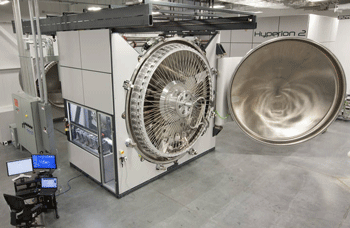- News
14 March 2012
Twin Creeks launches system for producing ultra-thin Si, Ge, GaN, SiC and sapphire wafers
 Twin Creeks Technologies of San Jose, CA, USA, which provides equipment for making thin crystalline wafers for solar and semiconductor manufacturers, has launched Hyperion, a wafer production system that can dramatically reduce the cost of solar modules and semiconductor devices by cutting the amount of silicon and other substrate materials used by up to 90%, it is reckoned.
Twin Creeks Technologies of San Jose, CA, USA, which provides equipment for making thin crystalline wafers for solar and semiconductor manufacturers, has launched Hyperion, a wafer production system that can dramatically reduce the cost of solar modules and semiconductor devices by cutting the amount of silicon and other substrate materials used by up to 90%, it is reckoned.
Picture: Twin Creeks’ Hyperion 3 system.
The key to Hyperion is thinness. Taking advantage of Proton Induced Exfoliation (PIE) technology, Hyperion generates monocrystalline wafers that are less than a tenth of the thickness of conventional wafers. With thin wafers, manufacturers can profitably produce solar cells and other devices well below the current best-in-class cost structure, it is claimed. Twin Creeks estimates that Hyperion will allow manufacturers to produce solar cells for under 40 cents a watt in commercial-scale volume production facilities, with prices declining over time.
Hyperion 3, the third-generation wafer production system designed and built by Twin Creeks, is its first commercial offering, available for shipment now.
“The thickness of wafers today is based on wafer slicing capabilities and the handling requirements for device processing,” says CEO Dr Siva Sivaram. “In reality, only the very top layer of a substrate plays an active role in generating energy or transmitting signals - the rest is wasted,” he adds. “By eliminating excess material, we will help solar manufacturers produce modules that compete with grid power and open up new markets for chip makers.”
With PIE, Hyperion effectively uses atoms as a scalpel, Twin Creeks says. Hyperion embeds a uniform layer of high-energy protons (hydrogen ions) into monocrystalline wafers to a depth of up to 20µm. When heated, this new layer expands, cleaving the top surface from the donor wafer to form an ultra-thin wafer that is otherwise identical to the original. This is then further processed into solar modules or semiconductors. Creating wafers with PIE also eliminates the kerf (wasted silicon) in solar manufacturing.
Hyperion is compatible with a wide variety of monocrystalline wafers - including germanium (used in making concentrated PV solar modules), gallium nitride, sapphire and silicon carbide (for LEDs and power electronics). Twin Creeks initially concentrated on helping manufacturers of crystalline silicon solar cells because of the urgent need to cut the cost of solar power. The lessons learned will further allow manufacturers to employ Hyperion for other applications, such as CMOS sensors.
By reducing the amount of silicon required in solar modules by 90%, Hyperion makes the entire silicon wafer value chain more efficient and lowers the capital needs of users, claims Twin Creeks, since manufacturers do not need as many saws, furnaces and crystal pullers to make the same amount of wafers.
The firm claims that Hyperion also improves the monocrystalline silicon value proposition in other ways. As well as being much lighter than conventional solar cells, cells produced with Hyperion wafers are also bendable, allowing manufacturers to consider flexible packaging and encapsulants for modules instead of glass.
Additional layers of photovoltaic material can be added to wafers as well: Twin Creeks has produced heterojunction solar cells (combining crystalline and amorphous silicon) in its development center. Over time, the combination of lower cost and lighter packaging will allow Twin Creeks customers to expand into other markets such as building-integrated photovoltaics (BIPV) and consumer electronics.
In keeping with providing a true manufacturing solution, Twin Creeks has developed intellectual property for creating and handling ultra-thin wafers as well as producing finished solar cells. This IP can be licensed to Twin Creeks’ customers.
Founded in 2008, Twin Creeks is backed by venture capital firms as well as loans and grants from the Mississippi Development Authority. As well as having R&D facilities in San Jose and Boston, the company- in collaboration with the state of Mississippi - has built a commercial-scale demonstration plant in Senatobia, MS, where Twin Creeks and its customers can fine-tune processes for generating ultra-thin solar modules and wafers with Hyperion. The plant is capable of producing 25MW of solar cells per year and will be expanded to 100MW. The firm has obtained UL and TUV certification for heterojunction technology-based panels made there. In addition, the firm aims to build facilities in Malaysia through a joint venture.
Ge wafers GaN wafers SiC wafers Sapphire wafers

